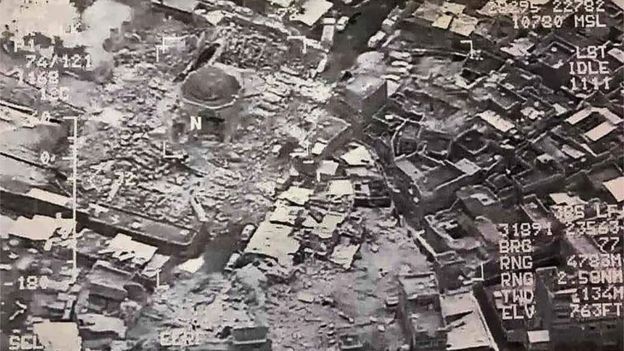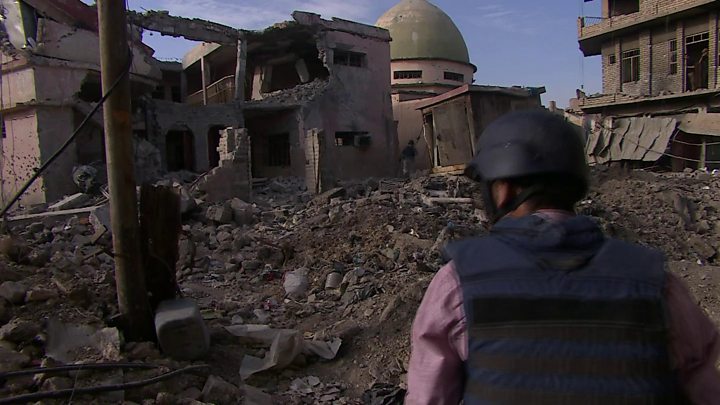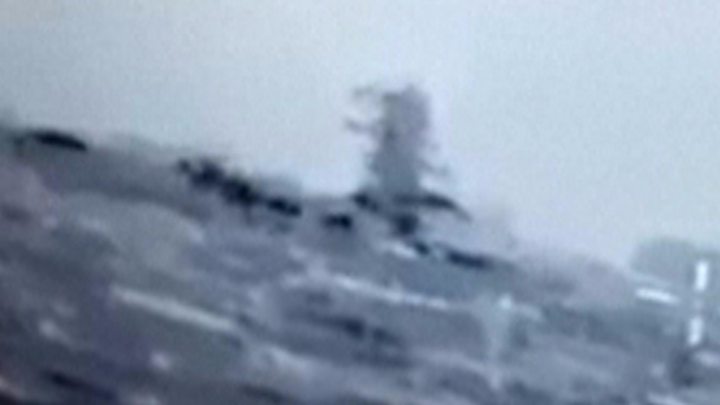Iraqi Prime Minister Haider al-Abadi says the destruction of an ancient mosque in the city of Mosul is "an official declaration of defeat" by so-called Islamic State (IS).
Iraqi forces say IS blew up the Great Mosque of al-Nuri and its famous leaning minaret as jihadists battled to stop advancing pro-government troops.
IS said American aircraft had destroyed the complex, a claim denied by the US.
Aerial photographs show the complex largely destroyed.
The mosque, which was more than 800 years old, was where in July 2014 IS leader Abu Bakr al-Baghdadi demanded allegiance in his first and only public appearance following the declaration days earlier of a "caliphate".
The mosque's destruction has brought widespread condemnation.
- Why Mosul’s Great Mosque of al-Nuri mattered
- WATCH: Mosul from above in 360 video
- Why IS militants destroy ancient sites
A senior US commander in Iraq said IS had destroyed "one of Mosul and Iraq's great treasures".
"This is a crime against the people of Mosul and all of Iraq, and is an example of why this brutal organisation must be annihilated," Maj Gen Joseph Martin said.
What happened to the Great Mosque?
The Iraqi commander in charge of the offensive to retake Mosul said troops were within 50m (160ft) of the mosque when IS "committed another historical crime".
Footage released by the Iraqi forces shows the ancient landmark being demolished.
 IRAQI JOINT OPERATION COMMAND
IRAQI JOINT OPERATION COMMAND
Previous reports said IS had rigged the mosque with explosives to stop the advance of Iraqi troops, but that local residents had until now prevented the militants from blowing it up.
Is the battle for Mosul over?
Thousands of Iraqi security forces, Kurdish Peshmerga fighters, Sunni Arab tribesmen and Shia militiamen, supported by US-led coalition warplanes and military advisers, have been involved in the battle to retake the key city since 17 October last year.
The government announced the full "liberation" of eastern Mosul in January, but the west of the city has presented a more difficult challenge, with its narrow, winding streets.
The UN has warned that IS may be holding more than 100,000 people in the city as human shields.

On Sunday, commanders announced the start of the "final chapter" of the offensive, with Iraq's counter-terrorism service, army and federal police attacking the Old City from all directions.
The army said it believed there were no more than 300 militants left in the city, compared with almost 6,000 in October.

On Tuesday, an Iraqi military statement on state TV said IS had lost control and civilians previously trapped in the Old City were being released.
The US military has hailed gains by Iraqi forces but says the full liberation of the city from IS control is not yet complete.
Why was the mosque important?
The al-Nuri mosque dated back to 1172 and was Mosul's most famous Sunni mosque. It was named after the Muslim leader, Nur al-Din Mahmoud Zangi, famous for waging jihad against Christian crusaders.
The leaning minaret was nicknamed "the hunchback".
 EPA
EPA
A month after IS forces overran Mosul in June 2014, Baghdadi gave a Friday sermon from the pulpit inside the mosque and spoke about the newly-proclaimed caliphate - a state governed in accordance with Islamic law, or Sharia, by God's deputy on Earth, or caliph.
The militant group flew its black flag from the famous minaret and the building became the centre of IS activities.
Why would IS blow it up?
IS fighters have shown scant regard for history or culture in the three years since their lightning advance across northern Iraq, says Paul Adams, BBC News world affairs correspondent.
Destruction of the mosque, most observers assumed, would mark the group's final act of angry defiance before finally losing their grip on Mosul.
IS claims that the mosque was destroyed by a US air strike. This seems unlikely, our correspondent says, but such is the savage nature of the struggle for control of Mosul that preserving the city's cultural and religious heritage has not been a high priority for anyone involved.
As well as targeting Christian and pre-Islamic sites such as Palmyra in Syria, IS militants have previously destroyed other, chiefly Shia, places of Muslim worship.
In Mosul, they have already targeted several mosques and tombs, including The Shrine of Yunus.
Sign up here with your email



